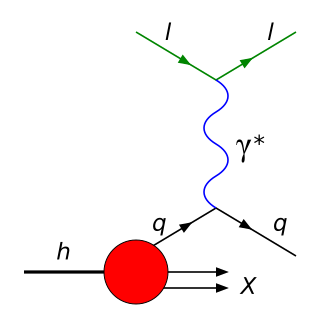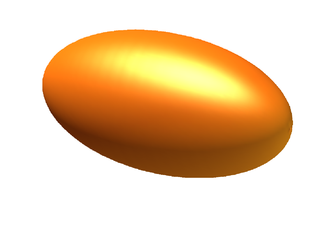Related Research Articles

The neutron is a subatomic particle, symbol
n
or
n0
, which has a neutral charge, and a mass slightly greater than that of a proton. Protons and neutrons constitute the nuclei of atoms. Since protons and neutrons behave similarly within the nucleus, they are both referred to as nucleons. Nucleons have a mass of approximately one atomic mass unit, or dalton. Their properties and interactions are described by nuclear physics. Protons and neutrons are not elementary particles; each is composed of three quarks.

In physics and chemistry, a nucleon is either a proton or a neutron, considered in its role as a component of an atomic nucleus. The number of nucleons in a nucleus defines the atom's mass number.

Gargamelle was a heavy liquid bubble chamber detector in operation at CERN between 1970 and 1979. It was designed to detect neutrinos and antineutrinos, which were produced with a beam from the Proton Synchrotron (PS) between 1970 and 1976, before the detector was moved to the Super Proton Synchrotron (SPS). In 1979 an irreparable crack was discovered in the bubble chamber, and the detector was decommissioned. It is currently part of the "Microcosm" exhibition at CERN, open to the public.
The European Muon Collaboration (EMC) was formed in 1973 to study the interactions of high energy muons at CERN. These experiments were motivated by the interest in determining the quark structure of the nucleon following the discovery of high levels of deep inelastic scattering at SLAC.

The nuclear force is a force that acts between hadrons, most commonly observed between protons and neutrons of atoms. Neutrons and protons, both nucleons, are affected by the nuclear force almost identically. Since protons have charge +1 e, they experience an electric force that tends to push them apart, but at short range the attractive nuclear force is strong enough to overcome the electrostatic force. The nuclear force binds nucleons into atomic nuclei.

In particle physics, deep inelastic scattering is the name given to a process used to probe the insides of hadrons, using electrons, muons and neutrinos. It was first attempted in the 1960s and 1970s and provided the first convincing evidence of the reality of quarks, which up until that point had been considered by many to be a purely mathematical phenomenon. It is an extension of Rutherford scattering to much higher energies of the scattering particle and thus to much finer resolution of the components of the nuclei.
In particle physics, the parton model is a model of hadrons, such as protons and neutrons, proposed by Richard Feynman. It is useful for interpreting the cascades of radiation produced from quantum chromodynamics (QCD) processes and interactions in high-energy particle collisions.

The Mainz Microtron, abbreviated MAMI, is a microtron which provides a continuous wave, high intensity, polarized electron beam with an energy up to 1.6 GeV. MAMI is the core of an experimental facility for particle, nuclear and X-ray radiation physics at the Johannes Gutenberg University in Mainz (Germany). It is one of the largest campus-based accelerator facilities for basic research in Europe. The experiments at MAMI are performed by about 200 physicists of many countries organized in international collaborations.

The NA58 experiment, or COMPASS is a 60-metre-long fixed-target experiment at the M2 beam line of the SPS at CERN. The experimental hall is located at the CERN North Area, close to the French village of Prévessin-Moëns. The experiment is a two-staged spectrometer with numerous tracking detectors, particle identification and calorimetry. The physics results are extracted by recording and analysing the final states of the scattering processes.

The atomic nucleus is the small, dense region consisting of protons and neutrons at the center of an atom, discovered in 1911 by Ernest Rutherford based on the 1909 Geiger–Marsden gold foil experiment. After the discovery of the neutron in 1932, models for a nucleus composed of protons and neutrons were quickly developed by Dmitri Ivanenko and Werner Heisenberg. An atom is composed of a positively charged nucleus, with a cloud of negatively charged electrons surrounding it, bound together by electrostatic force. Almost all of the mass of an atom is located in the nucleus, with a very small contribution from the electron cloud. Protons and neutrons are bound together to form a nucleus by the nuclear force.
Quantum chromodynamics binding energy, gluon binding energy or chromodynamic binding energy is the energy binding quarks together into hadrons. It is the energy of the field of the strong force, which is mediated by gluons. Motion-energy and interaction-energy contribute most of the hadron's mass.
The EMC effect is the surprising observation that the cross section for deep inelastic scattering from an atomic nucleus is different from that of the same number of free protons and neutrons. From this observation, it can be inferred that the quark momentum distributions in nucleons bound inside nuclei are different from those of free nucleons. This effect was first observed in 1983 at CERN by the European Muon Collaboration, hence the name "EMC effect". It was unexpected, since the average binding energy of protons and neutrons inside nuclei is insignificant when compared to the energy transferred in deep inelastic scattering reactions that probe quark distributions. While over 1000 scientific papers have been written on the topic and numerous hypotheses have been proposed, no definitive explanation for the cause of the effect has been confirmed. Determining the origin of the EMC effect is one of the major unsolved problems in the field of nuclear physics.

In strong interaction physics, light front holography or light front holographic QCD is an approximate version of the theory of quantum chromodynamics (QCD) which results from mapping the gauge theory of QCD to a higher-dimensional anti-de Sitter space (AdS) inspired by the AdS/CFT correspondence proposed for string theory. This procedure makes it possible to find analytic solutions in situations where strong coupling occurs, improving predictions of the masses of hadrons and their internal structure revealed by high-energy accelerator experiments. The most widely used approach to finding approximate solutions to the QCD equations, lattice QCD, has had many successful applications; however, it is a numerical approach formulated in Euclidean space rather than physical Minkowski space-time.

James Daniel "BJ" Bjorken is an American theoretical physicist. He was a Putnam Fellow in 1954, received a BS in physics from MIT in 1956, and obtained his PhD from Stanford University in 1959. He was a visiting scholar at the Institute for Advanced Study in the fall of 1962. Bjorken is emeritus professor in the SLAC Theory Group at the Stanford Linear Accelerator Center, and was a member of the Theory Department of the Fermi National Accelerator Laboratory (1979–1989).

The idea that matter consists of smaller particles and that there exists a limited number of sorts of primary, smallest particles in nature has existed in natural philosophy at least since the 6th century BC. Such ideas gained physical credibility beginning in the 19th century, but the concept of "elementary particle" underwent some changes in its meaning: notably, modern physics no longer deems elementary particles indestructible. Even elementary particles can decay or collide destructively; they can cease to exist and create (other) particles in result.

The light-front quantization of quantum field theories provides a useful alternative to ordinary equal-time quantization. In particular, it can lead to a relativistic description of bound systems in terms of quantum-mechanical wave functions. The quantization is based on the choice of light-front coordinates, where plays the role of time and the corresponding spatial coordinate is . Here, is the ordinary time, Failed to parse : {\displaystyle z} is a Cartesian coordinate, and is the speed of light. The other two Cartesian coordinates, and , are untouched and often called transverse or perpendicular, denoted by symbols of the type . The choice of the frame of reference where the time and -axis are defined can be left unspecified in an exactly soluble relativistic theory, but in practical calculations some choices may be more suitable than others. The basic formalism is discussed elsewhere.
In high energy particle physics, specifically in hadron-beam scattering experiments, transverse momentum distributions (TMDs) are the distributions of the hadron's quark or gluon momenta that are perpendicular to the momentum transfer between the beam and the hadron. Specifically, they are probability distributions to find inside the hadron a parton with a transverse momentum and longitudinal momentum fraction . TMDs provide information on the confined motion of quarks and gluons inside the hadron and complement the information on the hadron structure provided by parton distribution functions (PDFs) and generalized parton distributions (GPDs). In all, TMDs and PDFs provide the information of the momentum distribution of the quarks, and the GPDs, the information on their spatial distribution.
Haiyan Gao is a Chinese-American nuclear physicist whose research concerns the structure of nucleons, quantum chromodynamics, and low-energy fundamental symmetries and symmetry violations, and has included accurate measurements of the size of protons. She is the Henry W. Newson Distinguished Professor of Physics at Duke University, and associate laboratory director for nuclear and particle physics at the Brookhaven National Laboratory. Beyond her research in physics, she is also known as having a "keen interest in promoting diversity, equity, and inclusion in the sciences".
The nucleon magnetic moments are the intrinsic magnetic dipole moments of the proton and neutron, symbols μp and μn. The nucleus of an atom comprises protons and neutrons, both nucleons that behave as small magnets. Their magnetic strengths are measured by their magnetic moments. The nucleons interact with normal matter through either the nuclear force or their magnetic moments, with the charged proton also interacting by the Coulomb force.

The shape of the atomic nucleus depends on the variety of factors related to the size and shape of its nucleon constituents and the nuclear force holding them together. The origins of nuclear shape begin with the spacial extent of almost nearly all stable and a great many unstable nuclei has been determined mainly by electron and muon scattering experiments as well as spectroscopic experiments. An important factor in the internal structure of the nucleus is the nucleon-nucleon potential, which ultimately governs the distance between individual nucleons, while a dip in the charge density of some light nuclide structures a lesser density of nucleonic matter. A surprising non-spherical expectation for the shape of the nucleus originated in 1939 in the spectroscopic analysis of the quadrapole moments while the prolate spheroid shape of the nucleon arises from analysis of the intrinsic quadruple moment. The simple spherical approximation of nuclear size and shape provides at best a textbook introduction to nuclear size and shape. The unusual cosmic abundance of alpha nuclides has inspired geometric arrangements of alpha particles as a solution to nuclear shapes, although the atomic nucleus generally assumes a prolate spheroid shape. Nuclides can also be discus-shaped, triaxial or pear-shaped.
References
- ↑ PDG Review (2015) on structure functions
- ↑ Charles Perdrisat and Vina Punjabi (2010). "Nucleon Form factors", Scholarpedia5(8): 10204. online article
- ↑ A. De Roeck and R.S. Thorne (2011). "Structure functions", Progress in Particle and Nuclear Physics66 (4) pp 727–781, doi : 10.1016/j.ppnp.2011.06.001